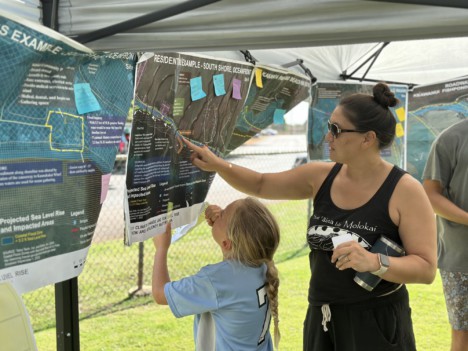CCSLAR Plan Moves Forward
By Maria Angst | Community Reporter

Photo courtesy of Sust’ainable Molokai.
Throughout October, Sustʻainable Molokai conducted multiple workshops to gather community feedback on their Molokai Climate Change and Sea Level Rise Adaptation and Resiliency plan (CCSLAR).
The workshops focused on reviewing the latest priority site maps, which now include coastal inundation zones, and selecting the mitigation strategies that the community believed were most suitable for the island and its residents.
The CCSLAR plan’s ultimate goal is to identify measures that will preserve natural and cultural resources from sea level rise while remaining cost-effective. The plan will span across decades.
The primary objective of this plan is to work closely with the community to pinpoint priority sites where sea level rise, erosion, and flooding are most critical, and to propose community-supported adaptation strategies to mitigate these impacts.
Current long-term strategies include plans for the retreat and relocation of homes, businesses, roads, and critical infrastructure threatened by sea level rise. Efforts are underway to ensure connectivity between different Molokai districts, incorporating both existing and potentially elevated road systems, according to a draft of the plan.
The plan places a strong emphasis on establishing, renewing, and preserving biocultural relationships to the changing shoreline. This involves maintaining existing trails for lateral and vertical access across ahupuaʻa, rebuilding loʻi to collect silt, and restoring loko iʻa (fishponds) with coral gardening and fish hales.
To enhance water and food security, the plan outlines a range of strategies including reforestation, reducing water diversions, and managing ungulate populations, like deer, as food sources. Resiliency hubs organized by communities are being proposed for emergencies and food security as part of the plan.
In addition, the draft also promotes traditional agriculture and aquaculture systems, retrofitting inter-island food transportation, and exploring carbon footprint reduction methods like electric vehicles and biofuel production. Legislative and policy actions are underway at county and state levels to support these initiatives.
“Our Molokai CCSLAR plan is a pilot project designed to study the impact of climate change on specific locations. For the priority locations chosen by the community, there are various mitigation strategies available for both residential and business owners to implement, ranging from short-term to long-term approaches. For instance, we provided examples for both residential and business sites on the south shore and east shore, as well as examples for fishpond sites and cultural Native Hawaiian sites,” said Heather Place, emergency and resiliency coordinator for Sust‘ainable Molokai.
According to Place, by incorporating these diverse locations, the community gains a set of day-to-day, year-to-year, and long-term, 10 years and beyond, plans. Currently, Sust’ainable Molokai’s plan focuses on identifying mitigation strategies for each location and gathering feedback from the community. This input helps them refine the plan by considering additional options they may not have initially thought of.
“Climate change, in conjunction with sea level rise, will impact our community, potentially even more significantly than it does now,” said Place. “Although these effects may not be immediate for me, they may manifest in the future for my keiki. Knowing that we are establishing these initial plans, which will evolve into more comprehensive strategies, provides us with the confidence that our community will be prepared.”
The Molokai CCSLAR plan is open for public comments until Nov. 30. View the plan and maps at linktr.ee/molokaiclimatechange.











Don't have a Molokai Dispatch ID?
Sign up is easy. Sign up now
You must login to post a comment.
Lost Password